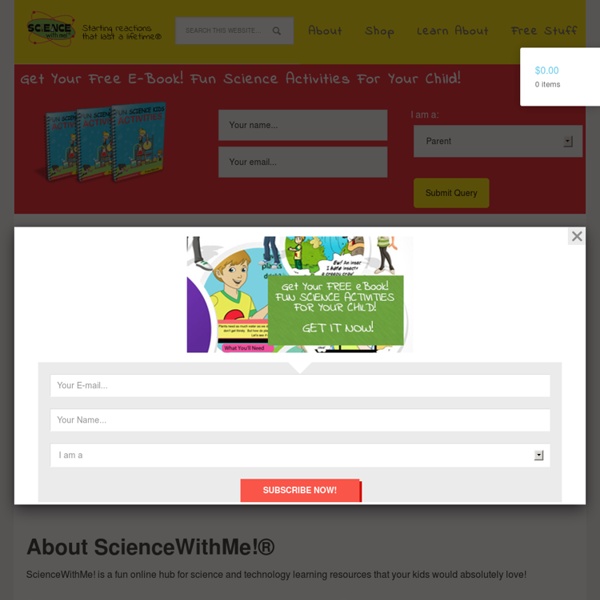



Science Matters Yah, I know some of us are winding down from schooling for the summer months, but I can’t help but stay on the lookout for resources I know I’m going to be needing again all too soon. I’ve come across some interesting science things of late that I want to check out – perhaps you, too, can find something useful. For your perusal: An Introduction to the 5 Senses Collection - Science for Kids Animation: Interested in learning about the body’s senses? Have your kids learn how we hear, see, smell, taste, and touch with this smashing educational science animation brought to you by Science With Me! This fun animation helps you learn and retain scientific information effortlessly. Soon you’ll be sounding like a scientific pro! Song: Sing the Science With Me! 5 senses song…This is one catchy song you’ll never forget!
Universities with the Best Free Online Courses Free online courses are offered by real schools. Learn which courses are available, what topics they cover and which ones lead to real college credit. Online Courses for Credit All of the schools listed below are well-known universities with a variety of free online course offerings. These classes are typically offered as part of an OpenCourseWare (OCW) project.
An Introduction to the Joints Collection - Science for Kids Animation: A little boy learns how his joints prevent him frombecoming a lump of jelly. This short fun animation will make you laughas you learn about bones, ligaments and muscles. Another must seeeducational video from Science With Me! * Video runs 1 min 30 seconds Song: How does the knee work? 5 Really Weird Things About Water Water, good ol' H2O, seems like a pretty simple substance to you and me. But in reality, water - the foundation of life and most common of liquid - is really weird and scientists actually don't completely understand how water works. Here are 5 really weird things about water:
An Introduction to the Human Skeleton Collection - Science for Kids Animation: This is undoubtedly a Science With Me! classic! “Stanleythe Skeleton” is one of the most popular science animations on theScience With Me! website. Learn all about the human skeleton withthe very spooky “Stanley the Skeleton”.
200 Free Online Classes to Learn Anything Written by: Thomas Broderick Universities, colleges, and private organizations offer free online college courses to help students acquire new knowledge and skills. These courses cover a variety of traditional academic topics and other subjects that can lead to career advancement and personal enrichment. Courses occur online, allowing learners from all over the world to participate. At the end of a course, students may qualify for an official certificate. Learn about Dinosaurs - Science for Kids If you have watched any of the Jurassic Park movies, you might find dinosaurs scary. What are dinosaurs? Dinosaurs were the main inhabitants of the earth starting about 230 million years ago and ending about 65 million years ago (late Triassic period to Cretaceous period). In phylogenetic classification, the word Dinosauria is a Superorder and is used to refer to all dinosaurs.
Ideas - TREEFINDER My subversive attempts to do something useful. The Rotary Piston Array Machine -- Air-Sea Temperature Difference Engine -- Solarthermal Power Generator The Rotary Stirling Engine The Wave Pump Heat Engine With No Compressor Portable Tent Platform The rotary piston array (RPA) is the possibly most compact and most elegant machine to transform the volumetric change of gas into shaft work and vice versa.
Learn about Blood - Science for Kids When you accidentally cut yourself while helping your mother peel potatoes or when you gain a bruise after playing football, you are actually witnessing blood at work. Blood delivers the nutrients needed by the different parts of the body. When you have enough blood, you are able to think, play and study at optimum levels. What are the components of blood? Einstein for Everyone Einstein for Everyone Nullarbor Press 2007revisions 2008, 2010, 2011, 2012, 2013 Copyright 2007, 2008, 2010, 2011, 2012, 2013 John D. Norton Published by Nullarbor Press, 500 Fifth Avenue, Pittsburgh, Pennsylvania 15260 with offices in Liberty Ave., Pittsburgh, Pennsylvania, 15222 All Rights Reserved
Learn about Transport in Plants - Science for Kids Like you and all other living organisms in the world, plants need water and nutrients from the environment in order to survive. Different parts of the plant are involved in transport or movement of water and nutrients. These parts are the roots, the stem and the leaves. The transport system of plants works similar to your circulatory system.